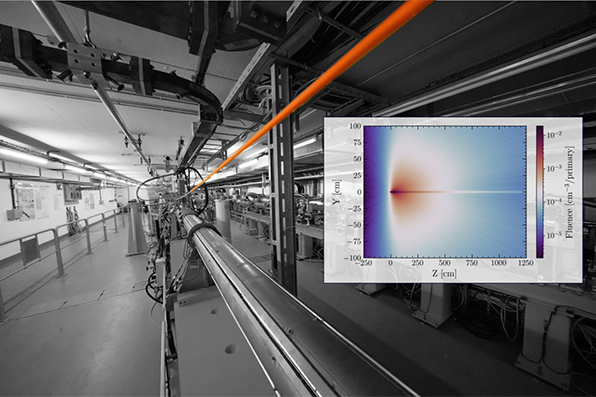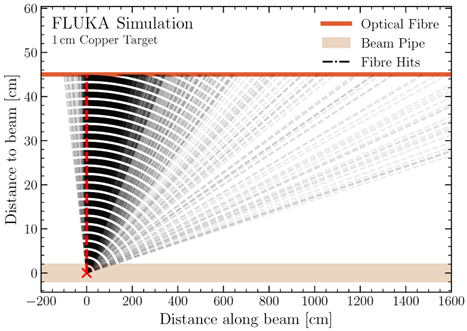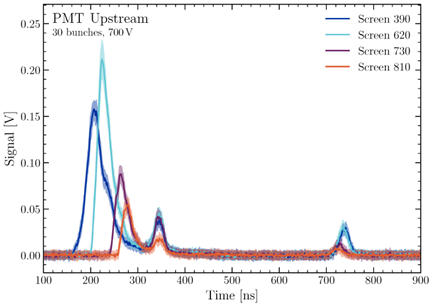Position-Reconstruction Methods for Beam Losses Measured with an oBLM at CLEAR

While the basic principles of particle accelerators may be simple, using electric fields to accelerate particles and magnetic fields to steer them, actually operating them is highly complex. Even small changes in the starting conditions or shifts in the relative positioning of different elements, caused by temperature fluctuations or other movements, can lead to drastically differing beam trajectories. In most cases, this causes the beam to be lost, partially or completely, before the end of the beam line, creating particle loss showers.

Simulated particle loss shower created by inserting a 1 cm thick copper target in the beam line. (Image credit: King, M. et al. Instruments 2025, 9(1), 4. CC BY 4.0)
Apart from reducing the available beam intensity at the end of the beam line and thus increasing the overall beam time necessary to perform experiments, these beam losses also damage devices surrounding the beam pipe such as beam instrumentation or magnets. To be able to detect the magnitude and position of such beam losses, beam loss monitors (BLMs) are used. Ideally, these give information which can be used to adjust magnets along the beam line to minimise the amount of beam loss.
The most common type of BLM are ionisation chambers. These detect beam loss events and give a signal proportional to the magnitude of the beam loss shower. The main drawback of this system is the small longitudinal coverage of these devices, typically covering <1m per device. This means that the beamline coverage is mainly determined by the number of installed BLMs and some blind spots will likely remain.
With this in mind, the QUASAR Group has been developing a novel type of beam loss monitor over the last few years. These so called optical BLMs use a relatively thick (> 200 µm) multimode optical fibre installed parallel to the beamline with photon-sensors attached at either end. Whenever charged particles from the beam-loss shower impact the fibre at a speed greater than the speed of light within the optical fibre (~66% of c), photons are generated within the fibre through the process of Cherenkov radiation. These photons can be transported through the fibre to the photon-sensors with the number of photons being proportional to the total amount of beam loss and the time of arrival being proportional to the loss position.
In the feature paper of the March 2025 issue of the journal Instruments, QUASAR PhD student Monty King and his co-authors investigated the position resolution of such a system they recently installed at the CERN linear electron accelerator for research (CLEAR). For this, they created beam losses at multiple known positions along the beamline by inserting beam screens into the beam line. They then analysed different algorithms which were used to convert the measured waveforms into timestamps and then reconstructed loss positions. These were compared to known beam screen locations. This allowed the researchers to quantify the accuracy of the different algorithms.

A plot showing example upstream waveforms. The time in nanoseconds is shown on the x-axis, with the signal in volts on the y-axis. To visualise statistical fluctuations, the standard deviations on the waveforms are given by the transparent bands. (Image credit: King, M. et al. Instruments 2025, 9(1), 4. CC BY 4.0)
This process was repeated for two different types of photon-sensors and a varying number of beam bunches. The most accurate combination was determined to be using the upstream readout and applying a constant fraction discrimination on the measured waveform. The investigated photon-sensors gave similar position resolutions.
These results can be applied to similar installations at accelerators around the globe, potentially increasing their accuracy by 10% or more. Further research is currently ongoing into additional possible position resolution improvements to the system. Furthermore, additional use cases for this installation apart from beam loss detection are under investigation.
Further information:
'A Systematic Investigation of Beam Losses and Position-Reconstruction Techniques Measured with a Novel oBLM at CLEAR', M. King, et al., Instruments 2025, 9(1), 4, https://doi.org/10.3390/instruments9010004